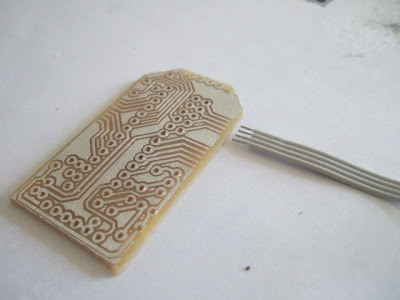The problem with fine-pitch soldering is getting the components tinned, and especially tinning fine multi-core cable. Tinning PCBs can be a problem, but with plenty of flux and a tiny amount of solder on your tip, this should be possible, even with a big tip. We've always found tinning multi-core cable to be really tricky!
The tiny thin strands in each core separate, the solder creates bridges between the different cores, separating the cores makes the wires heat up and melt the plastic coating and generally everything gets a bit messy!
While we're not quite ready for SMT soldering again yet, being able to pre-tin PCBs creates some exciting possibilities (though only really if you're excited by this sort of thing). Here's an example of how tinning can make soldering really easy (which is great if you're still having problems with big chunky through-hole components and massive 2mm pads!)

The job here is to solder the 0.05" pitch IDE cable to the traces on the edge of the PCB. Normally we'd use standard 0.1" pitch holes, split the cable at the ends and thread the individual wires through the holes and solder to the underside of the PCB. By using this new method, we don't have to drill as many holes on the board!
[EDIT: see last photo in this later post for an example of the "old way" of soldering IDE cable to our PCBs]
As always, we begin be covering the PCB traces with plenty of flux. Then just splodge a lump of solder paste across the traces to be soldered.

Hold the wires in place and heat up the solder paste with the tip of the soldering iron. We started by tacking the outer wires by heating the tracks rather than the actual wire. When the cable was held in place, we then put the tip of the iron directly on top of each core of the cable. You can see the solder paste melt and turn shiny. After a second or two, the solder starts to appear on the top of the wires - transferred, perhaps, by some form of capilliary action?

Anyway, whatever the reason, the end result is some beautifully soldered wires, no bridging (any excess solder paste is either burnt off or just runs towards the pre-tinned solder tracks) and a nice, strong, solder joint on each core of the cable.
The last thing to do is to test the continuity between the exposed ends of the cable (the opposite end to the one connected to the PCB) and the traces on the PCB. By testing "outside" each end of the solder joints, we can be confident that if we get continuity, the joint is good.

Any solder paste should do. We used this stuff. It was given to us by Matt from BuildBrighton. He said it was about 12 months out of date but had been hiding away in a cupboard and he had no plans to use it. Although the paste has a slight "crust" when we opened it, the paste underneath was still soft and usable.


No comments:
Post a Comment